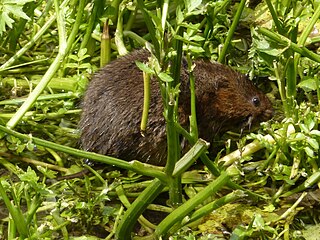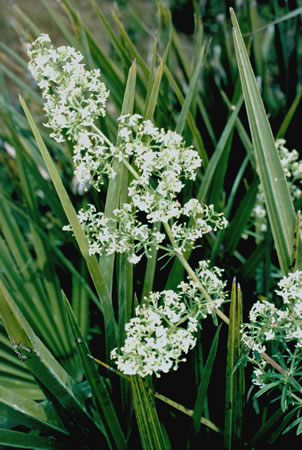A special area of conservation (SAC) is defined in the European Union's Habitats Directive (92/43/EEC), also known as the Directive on the Conservation of Natural Habitats and of Wild Fauna and Flora. They are to protect the 220 habitats and approximately 1,000 species listed in annex I and II of the directive which are considered to be of European interest following criteria given in the directive. They must be chosen from the sites of Community importance by the member states and designated SAC by an act assuring the conservation measures of the natural habitat.

Abies nebrodensis, the Sicilian fir, is a fir native to the Madonie mountains in northern Sicily.

Marsupella profunda, the western rustwort, is a liverwort native to Europe and known only from Portugal and Great Britain (Cornwall) and has been sighted in the Canary Islands. It is a small reddish liverwort and can be confused with Marsupella sprucei which has a more widespread distribution.

The United Kingdom Biodiversity Action Plan or (UK BAP) was the UK government's response to the Convention on Biological Diversity, opened for signature at the Rio Earth Summit in 1992. The UK was the first country to produce a national Biodiversity Action Plan. It was published in 1994 and created action plans for priority species and habitats in the UK that were most under threat so as to support their recovery.

Compton Martin Ochre Mine is a 0.85 hectare geological and biological Site of Special Scientific Interest located on the north side of the Mendip Hills, immediately south west of Compton Martin village, Somerset, notified in 1988.
The Habitats Directive is a directive adopted by the European Community in 1992 as a response to the Berne Convention. The European Community was reformed as the European Union the following year, but the directive is still recognised.
A Site of Community Importance (SCI) is defined in the European Commission Habitats Directive (92/43/EEC) as a site which, in the biogeographical region or regions to which it belongs, contributes significantly to the maintenance or restoration at a favourable conservation status of a natural habitat type or of a species and may also contribute significantly to the coherence of Natura 2000, and/or contributes significantly to the maintenance of biological diversity within the biogeographic region or regions concerned.

Anthemis glaberrima is a species of flowering plant in the family Asteraceae. It is found only in Greece. Its natural habitats are rocky shores and Mediterranean-type shrubby vegetation.

Helosciadium bermejoi, synonym Apium bermejoi, is a critically endangered species of flowering plant in the family Apiaceae.
Bupleurum kakiskalae is a species of flowering plant in the family Apiaceae. It is endemic to western Crete, an island which is part of Greece.
Naufraga balearica is an extremely rare species of flowering plant in the family Apiaceae, and the only species in the genus Naufraga. It is endemic to the Spanish island of Majorca, where it is found only at the base of cliffs at the north of the island near Pollença. A population was discovered on Corsica in 1981, but it had died out by 1983, and it is not clear whether it arrived naturally. Its natural habitats are Mediterranean-type shrubby vegetation and rocky shores.

Ophrys lunulata, the moon orchid, is a species of orchid native to the islands of Malta and Sicily in the central Mediterranean.

Broadhaven Bay is a natural bay of the Atlantic Ocean on the northwestern coast of County Mayo, Ireland. The opening of the bay faces northward, stretching 8.6 km between Erris Head in the west and Kid Island/Oileán Mionnán in the east.

Leopoldia gussonei is a plant in the family Asparagaceae, endemic to the Island of Sicily.

Galium litorale is a rare species of bedstraw in the Rubiaceae family. It is endemic to the island of Sicily in the Mediterranean Sea. In Italian it is known as caglio costiero.

Centaurea horrida is a species of the genus Centaurea which is only found growing in Sardinia and associated islands. Due to their limited ability to disperse, they are isolated from other environments, and have a very low colonizing ability.
Narcissus bujei is a species of the genus Narcissus (daffodils) in the family Amaryllidaceae. It is classified in Section Nevadensis. The flower is a plain yellow. It is native to the Andalusia region of Spain, in particular the Comarca of Subbética (Córdoba) and the Sierra de las Nieves in the Serranía de Ronda (Málaga). It is considered an endangered species. Its preferred habitat is calcareous soils in small forests and irrigated land.
Daphne rodriguezii is a shrub, of the family Thymelaeaceae. It is endemic to Menorca, one of the Balearic Islands that belongs to Spain.

Dioscorea chouardii is a herbaceous plant in the family Dioscoreaceae. It is endemic to a single cliff located in the Pyrenees of Aragon, Spain.

The biogeographic regions of Europe are biogeographic regions defined by the European Environment Agency. They were initially limited to the European Union member states, but later extended to cover all of Europe west of the Urals, including all of Turkey. The map of biogeographic regions is deliberately simplified and ignores local anomalies. It is intended primarily as a framework for coordinating and reporting overall results of conservation efforts.















